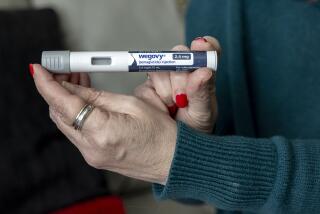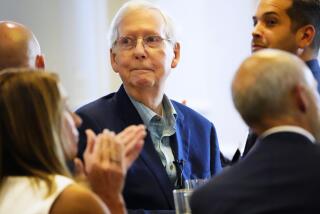Pills for What Ails You Socially
- Share via
NEW YORK — Shyness, once viewed as becoming in some people, is today being cast as a prevalent medical problem. Thankfully, shy people can receive relief in the form of a pill called Paxil. The medicine is an old drug being applied to a novel disease called “social anxiety disorder.” Both the disease and the drug are largely the innovation of the drug’s manufacturer and its Madison Avenue advertising agency.
In the past, medical professionals wouldn’t dare to prescribe a powerful psychotropic drug like Paxil to treat the benign personality traits portrayed in the drug’s advertisements. Instead, medication was reserved for the few people who met rigid criteria defining serious mental illnesses. Yet, the race is on to develop pills that will satisfy social needs, a pursuit that often blurs the line separating treatment of purely clinical conditions from the medical manipulation of social stigmas.
Definitions of illness and health no longer belong strictly to the white-coated realm of pure science. They also are social, cultural and economic phenomena. Madison Avenue executives are hard at work recasting bothersome physical traits with memorable names and deceivingly broad descriptions to expand potential markets for dozens of new medications.
Four years ago, the disease “overactive bladder” barely existed in medical textbooks. Now everyone knows there’s a drug to stop those annoying trips to the bathroom. Every man who has problems during sexual relations has an organic etiology called “erectile dysfunction.” Allergy medications are being peddled for a wide variety of sniffles that go well beyond clinical definitions of hay fever. In the case of all these afflictions, while a select group of people will certainly benefit from treatment, the aim of advertising executives is to stretch the clinical definitions to expand the market for new drugs and convince millions of new consumers that they’re affected with a condition that requires medication.
When drug companies and advertising executives connect, the bounty can be enormous. In Colorado, legislation is being proposed that would mandate that obesity be considered a “disease.” The bill, mirroring legislative efforts in other states, would make prevention of portliness and its treatment a matter of state policy. Classifying obesity as a disease sets the stage for reimbursement for two new and expensive fat-busting drugs by private and public health insurance. It also makes it easier for people to talk about their weight in the language of victims and seek out the expensive medications. Doctors expect prescriptions for anti-obesity medication to grow exponentially if these legislative efforts succeed.
Physicians and pharmaceutical firms used to abide by the distinction between being sick and not feeling your best. If you were sick, they were there to help. If other things weren’t going too well, you just had to learn to live with them. Today, many doctors are privately and publicly complaining that the pendulum has swung too far, with too many pills being prescribed for too many soft diagnoses.
In a study published recently in the Journal of the American Medical Assn., researchers reported that the use of certain psychotropic drugs such as Ritalin in 2- and 4-year-olds doubled and even tripled during the last decade. The study gave no reasons for the increase, but experts say frustrated parents, agitated day-care workers and 10-minute pediatric visits all contribute to quick pharmacological fixes for emotional and behavioral problems.
Powerful drugs were previously reserved for children with genuine brain disease. Now it’s commonplace for them to be labeled with a “hyperactivity” disorder requiring medication. The best-selling book “Listening to Prozac” helped fuel this boom in 1993, injecting the phrase “cosmetic pharmacology” into the vernacular and breaking the conceptual groundwork for advocates of Ritalin. Even the diseases themselves have undergone some creative updates. “Attention deficit disorder” and “hyperactive disorder” were formerly known as “minimal brain damage.” The pharmaceutical companies, to accommodate marketing goals, changed the names.
These efforts have helped get 4 million extra-lively, fidgety and easily distractible kids on Ritalin and 2.5 million on antidepressants. Ironically, in a country where every child from preschool onward can recite antidrug catechisms, millions of children are legally drugged with a substance so similar to cocaine that, according to one medical journal, “It takes a chemist to tell the difference.” As with social phobia, the research and marketing of attention deficit disorder, an affliction that barely registered in the professional literature a decade ago, illustrates how certain normal traits can be recast as medical symptoms with the right mix of modern medicine and savvy marketing. The rest of the world, it should be noted, has yet to acquire the American taste for Ritalin. Today, America consumes 90% of the drug produced.
Probably the most important medical development of the 20th century was that economics replaced curiosity as the driving force behind research. Cashing in on the real and imaginary health anxieties of Americans is a lucrative business. Drug firms make the right noises about responsible use of their products, but their sales reps are in doctors’ offices every day, pitching the products.
Individual pleasure has its natural and indispensable place, even in medicine, but like a powerful engine, it has to be integrated with the rest of the social machinery. Doctors must be willing to differentiate between the demands of a generation of affluent self-medicators and those with real medical needs. It is madness to make self-satisfaction an end in itself, to which everything else must be sacrificed. *






